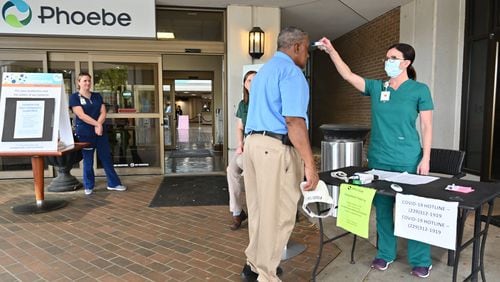As COVID-19 swept over Phoebe Putney Health System and Southwest Georgia in the first days of the pandemic, residents and public health officials were desperate to know what patients had and how far it was spreading. The Albany, Georgia-based outbreak turned out to be one of the four largest in the world in terms of the percentage of the population infected, along with Wuhan, New York, and Northern Italy, and it was only the beginning.
Four years later, a warning system exists, but a big part of it is being switched off. Effective this month, the federal government’s pandemic emergency requirement that all hospitals report their number of COVID-19 patients has expired.
COVID cases are at a low ebb, and the Biden administration last year lifted the pandemic public health emergency orders. By doing that, federal officials estimated that their protective value was no longer worth the extra work and obstacles to daily life that they create. Lifting the emergencies is also acknowledgment of the need to limit government intrusion on rights.
Hell no. I don’t want them enacting emergency powers ever again.
— Josephine Annabell (@supplementsarge) February 8, 2023
But the CDC and some other public health officials say early warning systems are most valuable before a new emergency arrives. They hope hospitals will still voluntarily report what they’re seeing in COVID data to the CDC, even if they are short-staffed and the reporting takes extra work and time.
And it will take extra work on the ground. Unlike some other highly developed nations, the U.S. public health data system is clunky.
“We strongly encourage health departments and hospitals to continue reporting respiratory illness data through the National Healthcare Safety Network even though the CMS requirement has ended,” a CDC spokeswoman told The Atlanta Journal-Constitution in a written statement. “That data has significant value for protecting patient health and safety as well as public health.”
Nowadays, Phoebe Putney’s Cynthia Chaney or a couple of her colleagues spend 45 minutes every day typing in numbers by hand to report their COVID-19 case rates and vaccination status to CDC. It took them a month to learn how.
If the CDC system rejects Phoebe’s submission, it takes Chaney and her co-workers more time to troubleshoot why.
That’s par for the course in the jigsaw puzzle of U.S. public health computers. The sprawling collection of states, hospitals and counties with their own computer systems and their own reporting rules are a maze. They take enormous time and work to update.
Public health researchers looking to solve a health problem commonly find the most current national data set is two years old.
The national COVID-19 hospital data has been different for those researchers: with a click on a map, a reader could see whether a state’s case numbers in hospital beds were rising or falling in the last couple weeks. And if they were, were they very serious cases in ICU’s? Sometimes they weren’t: That meant a variant might be surging but it wasn’t on the verge of killing large numbers of people. In that case, different recommendations for people to mask or avoid crowds might come out.
All of that was ammunition for health officials to strategize: who to warn, who to move where, what equipment, testing and drugs to put in place.
With the reporting mandate expired, CDC said, it will rely on other sources of information, such as wastewater monitoring. Laboratories are still required to report cases they find. And CDC has worked with other federal agencies to suggest a new way of COVID reporting that it hopes will slim down the workload enough to be accepted as a requirement.
Come fall, when respiratory illness may fill up the hospitals again, it’s less certain whether public health officials will know how much of it is flu and how much of it is COVID.
The clunkiness of the U.S. system is absurd in the most advanced nation in the world for health care discoveries and seamlessly connected computer systems, said Dr. Carlos del Rio, distinguished professor of medicine in the Division of Infectious Diseases at Emory University School of Medicine. Del Rio has also had roles in hospital administration at Grady Health System.
Often the data that exists in places where patients’ problems are discovered never even gets gathered in a meaningful way, he said. “Frequently the health care data never makes it to public health,” del Rio said. “It doesn’t flow the way, like, bank data flows. I mean it’s amazing how the banking system knows exactly what’s going on, just because their systems work.”
He says that the question of whether to monitor disease spread at the federal level should not be a testy political question. But he understands, too.
It’s an old problem based on the fact that many Americans are suspicious of handing over control of their health data, del Rio conceded. And during the pandemic, while public health researchers started with high hopes the experience would push the nation to reform the health data system, the opposite happened. Suspicion and resistance to public health in some quarters exploded.
For the workers at Phoebe Putney, it’s all about helping their community. Chaney said she and her colleagues will keep doing the extra work as long as they can.
But hospitals across the nation are understaffed. Chaney herself is waiting to move into a role with more direct patient care. If something happens, the extra work may be too much.
“We want to support our community and the hospital,” Chaney said. “Especially since we were a hot spot.”
About the Author







